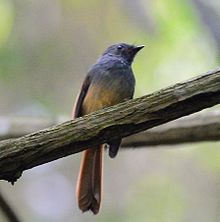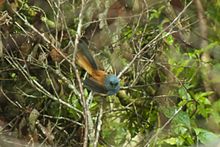| Blue-headed fantail | |
|---|---|

| |

| |
| Conservation status | |
 Least Concern (IUCN 3.1) | |
| Scientific classification | |
| Domain: | Eukaryota |
| Kingdom: | Animalia |
| Phylum: | Chordata |
| Class: | Aves |
| Order: | Passeriformes |
| Family: | Rhipiduridae |
| Genus: | Rhipidura |
| Species: | R. cyaniceps |
| Binomial name | |
| Rhipidura cyaniceps (Cassin, 1855) | |
The blue-headed fantail (Rhipidura cyaniceps) is a fantail endemic to the northern Philippines where it is found on the islands of Luzon and Catanduanes. Until recently, it was considered conspecific with the Tablas fantail and Visayan fantail.
Description and taxonomy
Ebird describes it as " A medium-sized, long-tailed bird of primary and secondary forest from the lowlands to the mountains on Luzon and Catanduanes. Dull blue on the head, chest, back, and shoulder, with some paler blue streaking on the chest and crown. Has a buff belly and rufous lower back, rump, outer tail feathers, and wing, with dark central tail feathers and a dark edge to the wing. Tail often cocked and fanned while foraging. Similar to Black-naped Monarch, but has a rufous rump and tail. Voice consists of single sharp “pik!” notes given at intervals or sped up into a rapid series."
Forms a species complex with the Tablas fantail and Visayan fantail. It is differentiated through molecular studies, voice, solid blue chest without shaft streaks and brown belly.
Subspecies
Two subspecies are recognized:
- R. c. cyaniceps – Found on Northwest Luzon down to the Bataan Peninsula
- R. c. pinicola– Northeast Luzon to the Bicol Peninsula and Catanduanes; slightly paler and smaller
The two subspecies are poorly differentiated and may possibly be invalid - more study is required.
Ecology and behavior
Forages in the understory for insects and often joins mixed-species flocks that include Golden-crowned babbler, Lemon-throated leaf warbler, Black-crowned babbler Little pied flycatcher, Turquoise flycatcher, Negros leaf warbler and other small birds. Not much known about its breeding information but breeding season is believed to in February to May, in line with most other Philippine forest birds.
Habitat and conservation status
Its natural habitats are tropical moist lowland forest and tropical moist montane forest up to 2,000 meters above sea level, it is seen in a wide array of forest types from lowland Dipterocarpus forests and montane pine, oak and laurel forest. The IUCN has classified the species as being of Least Concern where it is said to be locally common and the population is believed to be stable due to its general adaptability and tolerance for degraded forest.
It is found in multiple protected areas such as Mount Banahaw, Mount Makiling, Mount Isarog, Bataan National Park and Northern Sierra Madre Natural Park but like all areas in the Philippines, protection is lax and deforestation and hunting continues despite this protection on paper.
References
- BirdLife International (2016). "Rhipidura cyaniceps". IUCN Red List of Threatened Species. 2016: e.T103707823A94089722. doi:10.2305/IUCN.UK.2016-3.RLTS.T103707823A94089722.en. Retrieved 12 November 2021.
- Sánchez-González, L. A.; Moyle, R. G. (2011). "Molecular systematics and species limits in the Philippine fantails (Aves: Rhipidura)". Molecular Phylogenetics and Evolution. 61 (2): 290–9. doi:10.1016/j.ympev.2011.06.013. PMID 21722744.
- "Blue-headed Fantail - eBird". ebird.org. Retrieved 2024-09-07.
- ^ Boles, Walter; Christie, David (2020). "Blue-headed Fantail (Rhipidura cyaniceps), version 1.0". Birds of the World. doi:10.2173/bow.blhfan1.01. ISSN 2771-3105.
- IUCN (2016-10-01). Rhipidura cyaniceps: BirdLife International: The IUCN Red List of Threatened Species 2016: e.T103707823A94089722 (Report). International Union for Conservation of Nature. doi:10.2305/iucn.uk.2016-3.rlts.t103707823a94089722.en.
External links
- Image at ADW Archived 2008-12-02 at the Wayback Machine
| Taxon identifiers | |
|---|---|
| Rhipidura cyaniceps |
|
This Rhipiduridae-related article is a stub. You can help Misplaced Pages by expanding it. |